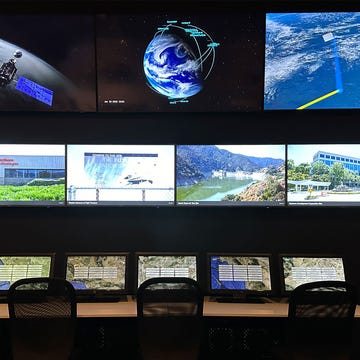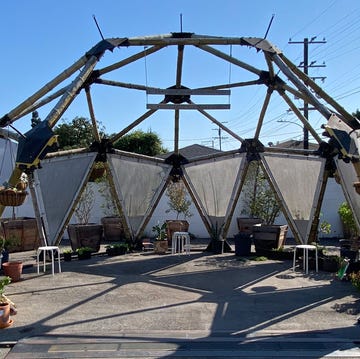Welcome to Alta Sketchbook, your guide to Getty’s PST Art: Art & Science Collide festival.
PST Art is the largest art event in the United States. Every Friday, Alta Sketchbook will offer the most intriguing takeaways from the 800-plus artists exploring the collision of art and science through exhibitions across Southern California.
Sign up for our weekly email to have our reviews and recommendations delivered straight to your inbox. And to read our previous coverage, visit Alta Sketchbook: PST Art.
A computer-generated tapestry at Pacific Design Center in Los Angeles tells a curious story. While traditional wall hangings often chronicle history, Jennifer Chen’s artwork records a memory from the future: the first boat leaving for Planet City—a utopia built on Earth for 10 billion people, the projected human population in 2050.
The 21-by-4½-foot futuristic textile captures the story from a satellite view as the entire world’s population migrates to one incredibly congested urban center (i.e., Planet City). One corner of the tapestry depicts people traveling; as you follow along, you observe patches of darkness appear that represent swaths of the globe going dark. In another corner, the pink lights of Planet City—which Chen renders with beads sewn onto the fabric—flicker on, buzzing ethereally.
Chen’s tapestry is included in Views of Planet City, part of Getty’s PST Art: Art & Science Collide festival. This two-site group exhibition at the Southern California Institute of Architecture and PDC is the latest incarnation of Planet City, a project begun by speculative architect Liam Young in 2021 that asks artists to imagine a future in which humans attempt the most daring of solutions to the climate change crisis: surrendering Earth to wilderness. The PST show features a dizzying array of multimedia artworks: miniature models of streets and apartments, digital graphics explaining Planet City’s agricultural systems, video work capturing renderings of the metropolis, and mountains of mulch sprouting ceramic flowers and other objects representing rewilding efforts.
These myriad works, especially the videos, transfer the idea of Planet City from the purview of science fiction to the realm of possibility. At SCI-Arc, a short film directed by Young depicts people in colorful masks during religious festivals in Planet City; at PDC, a video feature titled Pink Earth, another work by Chen, recounts the migration to the urban center.
Young, whom I spoke with at SCI-Arc, insists that the plausibility of Planet City is the point of this exhibition. Standing in the dark gallery, his face lit only by flickering screens, he explains that humanity today has the means to save Earth. “In many ways,” he claims, “Planet City is already here.”
This interview has been edited for brevity and clarity.
Ajay Orona: What was the genesis of Planet City?
Liam Young: During COVID, we heard a lot of cautionary tales about climate change that focused on technologies. Essentially, the idea was that newer technologies could save the environment and we had to trust that process. That is simply Silicon Valley hype. Trying to outdo each other with technology is a large part of what got us here in the first place.
We flipped that idea on its head with Planet City. Instead, we focused on optimism and hope. This utopia has no new technologies, no new minerals, no tech, no test tubes. The answer to climate change is not technological; it’s cultural. We are not inventing anything in Planet City. The vertical farms, the metals, the structures—they are already present in the world. We are extracting and mining culture.
Film plays a major role in this exhibition. Why was cinematic storytelling important to you and your team?
In many ways, how we relate to the future is conditioned by how we see the future in the mediums of film and popular culture. We are all literate in stories—and they are accessible and public in a way that architectural drawings, diagrams, or other disciplinary-specific mediums are not. Fiction is an extraordinary shared language; it is how cultures communicate and disseminate ideas. At this moment, I think we need to define a new language for the future.
Was there an actual location that you studied to conceive Planet City?
Planet City is more like an urban sprawl that would take up 2 percent of the earth’s surface. It would be like the entire world population fitting into Texas. There was a location that we used as a model, but our team got too obsessed with the actual location of this place, so we’ve moved on from it to let it be a city of myth, like Atlantis.
Could Planet City become reality?
Planet City is not a plan for direct implementation, but rather serves as a grounded provocation that prototypes the necessary systemic and lifestyle changes that may be required in order for our world to continue to support human life. What comes into focus is not the extremes of this fictional city but the catastrophic models of everyday urbanism. The live-action dystopian film we all occupy in the present moment is just as fantastic, implausible, and incalculable as any science fiction imagining. In a world that cannot agree on truth, logic, or geography, Planet City is both already here and entirely imaginary.•
VIEWS OF PLANET CITY
Through Feb. 16, 2025
Pacific Design Center Design Gallery
8687 Melrose Ave., West Hollywood
Southern California Institute of Architecture
960 E. 3rd St., Los Angeles
Ajay’s Must-Sees
SCIENCE FICTION AGAINST THE MARGINS
From Star Wars to Megalopolis, the protagonists of most sci-fi movies are white males. This exhibition features films from creative visionaries who are recasting the genre as a medium to champion diversity. Look for Dystopian Futures, playing later this month. Through Dec. 14, Billy Wilder Theatre, Hammer Museum
COLOR IN MOTION: CHROMATIC EXPLORATIONS OF CINEMA
In the early 20th century, the work of inking and painting cels for animated films was relegated to women at the Walt Disney Company. This exhibition examines the role that women played in the development of motion pictures, celebrating cinematic achievements of the past while encouraging conversation about race and gender in modern films. Through July 13, 2025, Academy Museum of Motion Pictures
Upcoming Shows
THE BODY IS THE INTERFACE
Nov. 2, Redcat
ANDELL FAMILY SUNDAYS: GUIDE TO THE GALAXY
Nov. 10, Los Angeles County Museum of Art
ART, SCIENCE, AND WONDER IN THE MEDIEVAL WORLD
Nov. 10, Getty Center
Related Coverage
- “Liam Young’s ‘Views of Planet City’ Will Highlight SCI-Arc’s Exhibition Programming As Part of Pacific Standard Time This Fall,” Archinect
- “Views of Planet City,” Hube
Ajay Orona is an associate editor at Alta Journal. He earned a master’s degree from USC Annenberg’s School of Journalism in 2021 and was honored with an Outstanding Specialized Journalism (The Arts) Scholar Award. His writing has appeared in Los Angeles Review of Books, Ampersand, and GeekOut.



















